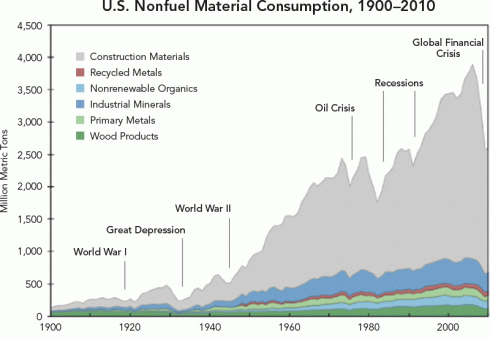Sustainable Materials
The Global Appetite for Materials
The amount of materials extracted, harvested and consumed worldwide has increased by 60 percent since 1980, reaching nearly 62 billion metric tons per year in 2008. Global demand for construction materials, food and feed and fossil energy makes up nearly 80 percent of this growth. The OECD countries account for about 38 percent of this consumption with Brazil, Russia, India, Indonesia, China and South Africa accounting for another 35 percent.1 Of the planet’s available 1.9 hectares per person of biologically productive land to supply resources and absorb wastes — the average person on Earth already uses 2.3 hectares worth. These “ecological footprints” range from the 9.7 hectares claimed by the average American to the 0.47 hectares used by the average Mozambican.
Material Consumption in the United States
The U.S. economy uses a vast amount of materials. With less than 5 percent of the world’s population, the United States uses one third of the world’s paper, 27 percent of the world’s aluminum and 19 percent of the copper.
Material consumption in the United States has been on a steady incline. The U.S. economy consumed 57 percent (by weight) more materials in the year 2000 than it did in 1975. Raw material use rose 2.8 times more than population from 1910 to 2010. By 2000, U.S. per capita total material consumption (including fuels) was 23.6 metric tons, 51 percent higher than the European average. Over the years there has been a steady shift from dense to less dense materials (from iron and steel to light metals, plastics and composites with a decline in the use of primary metals (except aluminum) and an increase in the use of plastics.2
Wasting Materials
In 2012, Americans generated about 251 million tons of municipal and commercial wastes or about 4.38 pounds of waste per person per day. Of this waste, about 65 million tons were recovered for recycling and 21 million tons for composting. This is equivalent to about 1.51 pounds recycled or composted per person per day and a national recycling rate of 34.5 percent of waste generated.3
Regulating Material Use
While there are regulations on the environmental impacts of extracting (mining, drilling) and harvesting (logging, farming) materials, the amount of materials, type of material, and where materials go is dictated largely by market forces. There are regulations on some chemical use in products, some safety regulations on products, and professional standards specifying product performance that affect material selection, but little regulation directly on material use. However, both state and federal governments regulate materials as wastes. Federal permits under the Resource Conservation and Recovery Act are required for the transport, storage and disposal of nearly 40 million tons of hazardous waste each year.
Building a Sustainable Materials Economy
We could continue to manufacture, use and dispose of materials at the rate we do in the United States, however, the costs would be high. The environmental damage from the accumulated waste stream would jeopardize the ecosystems of the planet and human health effects of continuous exposure to the hazardous chemicals in the materials would provide both human suffering and increasing costs for treatment. As the countries of the developing world increase in affluence they will press for an increasing share of the planet’s material wealth and this will increase global prices and tensions. Alternatively, we could pause and examine how we could live well, maintain a flourishing econom,y and use and dispose of a lot less. This will take some major changes not only in social values, but in laws, policies and practices. Such changes would not come easily, but now is the time, if we are going to build a safer and more environmentally compatible society.
Resources for Developing Sustainable Materials Policies
Materials Consumption
Grecia Matos and Lories Wagner, Consumption of Materials in the United States, 1900–1995. Washington, D.C., U.S.Geological Society, see http://pubs.usgs.gov/annrev/ar-23-107/aerdocnew.pdf.
Materials as Waste
Kenneth Orloff and Henry Falk, "An International Perspective on Hazardous Waste Practices", International Journal of Hygiene and Environmental Health 206:4-5, 2003, pp. 291- 302.
U.S. Environmental Protection, Agency, Municipal Solid Waste Generation, Recycling and Disposal in the United States, Facts and Figures for 2012, Washington, DC, 2013
Materials Recyling
Ida Ferrara, "Waste Generation and Recycling", OECD Journal: General Papers, Vol. 2008/2, DOI, 2008, see http://dx.doi.org/10.1787/gen_papers-v2008-art10-en.
Keep Amerca Beautiful, Recycling Facts and Stats, Internet, see http://www.kab.org/site/PageServer?pagename=recycling_facts_and_stats
Materials Management Policy
Organization for Economic Cooperation and Development (OECD), Materials, Resources, Productivity and the Environment: Key Findings, Paris, 2013
U.S. Environmental Protection Agency, Sustainable Materials Management: The Road Ahead, Washington, DC, 2009.
Sustainable Materials Management
Michael Baungart and William McDonough, Cradel to Cradle: Remaking the Way We Make Things, North Point Press, 2002.
Jullian M. Alwood and Jonathan M. Cullen, Sustainable Materials with Both Eyes Open, Cambridge University, 2012.
Rob Thompson, Sustainable Materials, Processes and Production, Thames and Hudson, 2013.
Organization for Economic Cooperation and Development, Sustainable Materials Management: Making Better Use of Resources, OECD Publications, 2012.
- OECD, Materials, Resources, Productivity and the Environment: Key Findings, Paris, 2013
- Center for Sustainable Systems, University of Michigan, U.S. Materials Use, 2013. Pub. No. CSS05-18
- U.S. Environmental Protection Agency, Municipal Solid Waste Generation, Recycling and Disposal in the United States, Facts and Figures for 2012, Washington, DC, 2013


